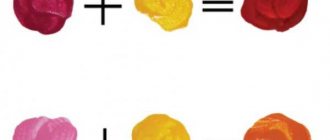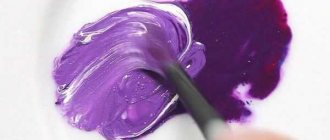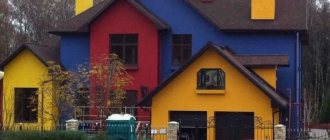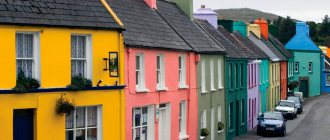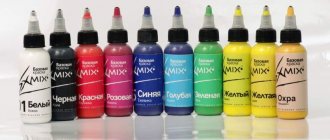Bright crimson color in the palette is located between red and pink. It is calm and noble, which is why it is considered in demand and is actively used in interiors.
Raspberry as accents is used in bedrooms and living rooms decorated in Empire, Renaissance, and Baroque styles. Beginning artists are often interested in how to get a crimson color; can this be done by mixing paints? It’s not difficult to create a shade with your own hands, you just need to know the tones suitable for combining.
Crimson and bright colors
Raspberry in combination with other colors behaves mainly in two different directions - bright and warm. Let's explain now.
Raspberry + blue
For example, raspberry and blue colors (both indigo and deep dark) together will look very bright and rich, such an image will be elegant and feminine.
It is suitable for business meetings, social events, and holidays.
Raspberry + brown
But crimson and brown colors in clothes will work in a completely different way, and the first thing that comes to mind is sweaters, jumpers, wool trousers, knitted dresses, jackets.
The difference in color development is hard to miss.
Raspberry + pink
You can also try raspberry color in collaboration with pink, but not pastel, so this combination should be diluted with someone else and more neutral.
In any case, it will be something quite bright that will require a minimum of accessories and intricate textures.
Raspberry + green
Raspberry combined with green in clothes, at first glance, sounds intimidating, but in fact it is a very harmonious tandem.
You can take it for an evening walk in the park (jeans, a green V-neck T-shirt and a raspberry long blazer), or on a more formal occasion (a raspberry tight-fitting plain dress and emerald accessories). This combination looks really very rich and noble.
Raspberry + yellow
Yellow, like lemon, will not always be a good company for raspberry. But it’s still worth a try, especially in spring or summer.
Choose clothes of simple styles from natural fabrics and play with these colors - it can turn out very fresh and juicy.
Bright crimson and its combination
Bright raspberry emphasizes the origin of the aspen shade from pink: if you lighten the medium raspberry, then you can just sleep in pink-raspberry. First of all, it evokes femininity, tenderness and at the same time the desire to stand out - beauty should be in plain sight. But it is beauty, since the brightness and lightness of the tone can harm a low-contrast appearance, highlight figure flaws, and paleness of the face. This tone will suit golden blondes and contrasting brunettes.
Bright crimson is combined with pink-peach, dark pink, mahogany, Jacco's last breath, carrot, apricot, bright gold, marsh, malachite, soft blue, royal blue, lavender, purple, red-brown, papyrus, wet asphalt .
Conversion
How to get brown color by mixing paints
Pigments from plants are used to dye fabric.
For painting, mixing of colors is also used to create a more accurate range.
What colors should you mix to make red? From the 3 basic ones - red, blue and yellow - all the rest are obtained.
In printing, they use a tone that is obtained by mixing two shades.
How to get red color when mixing paints:
- for printing it is made from two colors: magenta and yellow;
- to dye fabric or threads, you can mix pigments from the inflorescences of St. John's wort, safflower, northern bedstraw and madder roots;
- scarlet is obtained thanks to bedstraw flowers, for this you need to boil them for half an hour and add alum;
- To obtain a variety of shades, pigments are mixed: quinacridone violet, warm cadmium, burnt sienna or natural.
How to make red from pink? You need to mix pink with yellow, you get orange-red.
Curtains
How to get black by mixing paints
It is not necessary to focus on walls or furniture. You can choose crimson curtains. This interior design option is suitable for people who love change. If the curtains bother you, you can easily change them.
What combination of crimson color in the interior is considered classic? Take a look at Victorian interiors. In them, crimson curtains are adjacent to forged black furniture. If you like something modern, then you should give preference to white furniture. To support bright curtains, you can lay a rug of a similar color on the floor, and also decorate the coffee table with a crimson tablecloth.
Features of mixing artistic paints
How to get beige color when mixing paints
Different types of artistic paints produce unique effects when mixed. This depends on their chemical composition and the components necessary for diluting the pigments. Each material has its own subtleties and characteristics. This requires the painter to have a professional approach to work.
Watercolor paints
Watercolor paints are diluted with water. To obtain bright and rich shades in painting, it is necessary to take this nuance into account. Depending on the volume of water added, the watercolor paint will behave differently.
To obtain burgundy shades from watercolors, you can use the following names for shades of blue and red paint, depending on the manufacturer:
- Venetian red + ultramarine;
- cinnabar + indigo;
- cadmium red + Prussian blue;
- kraplak red + azure blue;
- scarlet + blue varnish.
Oil paints
Painting with oil paints requires a professional approach. This is a capricious material that requires special knowledge of different techniques and methods of mixing. With the help of oil paints, artists achieve a special volume and the necessary texture in their work.
In addition to the traditional mixing of colors on a palette, in oil painting, professionals often use illusionary mixing, which is created by applying paints of different colors close to each other. You can also use the method of multi-layer painting, when a tint layer with a translucent structure is applied on top of the main layer of paint.
You can learn more about the nuances and techniques of working with oil paints.
To obtain burgundy shades use:
- cadmium red + cobalt blue;
- iron oxide red + indigo;
- red kraplak + Prussian blue;
- scarlet + indanthrene blue;
- red quinacridone + ultramarine.
Acrylic paints
Acrylic is a universal paint that allows you to work on almost any surface. When dry, acrylic paint forms a smooth, glossy surface. The color obtained by mixing paints may differ after final drying. These subtleties must be taken into account when working with acrylic.
To obtain burgundy shades use:
- cinnabar + cobalt blue;
- carmine + indigo;
- Venetian red + ceruleum;
- cadmium red + turquoise;
- scarlet + ultramarine.
Tempera paints
Tempera paints have a dense, opaque and matte structure. When dry, tempera produces deep pastel colors, which, unlike acrylic, do not have a glossy sheen. Tempera works best on wooden surfaces, as it contains glue.
To obtain burgundy shades use:
- cadmium red + ceruleum;
- Venetian red + indigo;
- iron oxide red + turquoise;
- red kraplak + blue varnish;
- carmine + ultramarine.
Artistic gouache
Gouache, like watercolor, is diluted with water when mixed, but unlike watercolor paints, this material has a dense and opaque structure, reminiscent of tempera.
Unlike tempera, gouache does not have a strong adhesion to the surface, since it does not contain glue. Therefore, if you work with gouache without any water at all, when it dries it can crumble and crumble.
This material is perfect for children's creativity, as it is non-toxic, easy to use and can be easily washed off the skin with soap and water. To obtain burgundy shades, red and blue are traditionally used in a 4:1 ratio (with a predominance of red).
Rules for mixing paints
When creating a shade, it is important to consider the type of paint. Dried gouache will lighten a little, so make it darker than intended. When working with watercolors, you can add water instead of white paint, and oil allows you to mix directly on the canvas.
The color will come out pure and as close as possible to the idea, if you follow a few rules.
- You need to mix on a white surface: this will allow you to see the shade accurately.
- Start with a base color (red), then add accent paint (blue) to create crimson, not the other way around.
- You need to mix in the colors one after another, each time bringing the shade to uniformity.
- If adding paint from cans, pick up each color with a clean brush.
- In general, the total volume of additional colors should not exceed 20% of the base red.
Five ways
How to get red color when mixing paints
The most popular of them will be listed below.
Mixing paints
- The first way is to mix the orange and blue components with your own hands.
- The next method involves pairing red with green.
- The third option is to obtain brown from purple and yellow.
- Obtaining the desired color in an additional way.
- Mixing the main spectrum to obtain the desired shade.
Method No. 1
Orange + blue
- Let's see how to get a brown paint color and first we get an orange tone and for this the instructions are as follows: we will need red and yellow, where the first is given approximately 90%, and the second - 10% (you can vary a little, depending on the need, but you need a dark orange color). Try to ensure that the output solution is much closer to red than to yellow.
- Pour a little blue into the resulting mixture - its volume will be from 5% to 10% of the total composition, that is, for 90-95g of orange you need, respectively, 10-5g of blue composition. Increase the percentage until the mixture acquires a chocolate tone (if the solution is too light, add a little more blue).
- Please note that you will finally be able to figure out what the result will be only after the film has dried, but in any case, it will be much lighter than in the original state. Therefore, you can do a test on any surface, and then adjust the depth using blue or orange.
Method No. 2
Red + green
- Now let's see how to make brown from the paints shown in the top photo - red and green. If you don't have the last shade, you can make it by combining equal parts of blue and yellow paint. You will adjust the brightness by the amount of one or another paint, that is, make the ratio not fifty-fifty, but slightly changing the proportion of one or another component, depending on your need.
- After this, we begin to add the red component to the resulting solution until it darkens to the desired degree.
Method No. 3
Purple + yellow
- We continue to look at how to get brown from paints, and in this case we need to mix yellow and purple, but the first may not always be available, so you can make it yourself. To do this, we mix red and blue in equal parts and this way we get a dark, saturated solution of violet (do not forget that violet is located between blue and red in the color spectrum).
- Add yellowness little by little to the resulting mixture, just take your time so that you don’t end up with a too light solution - to do this you need to constantly stir the composition and this way you can control the proportions. For correction, you can slightly change the percentage, but it is best to do this after testing on any surface. The mixture can be used for both mineral surfaces and metal.
Method No. 4
Blue + yellow + red
- The fourth way to get brown paint is to spontaneously mix three primary colors, that is, first you pour two equal parts of two of them into one container, and then gradually add a third, getting the shade you need. In this case, the result will not be entirely predictable, since it will be difficult for you to adjust the proportions, but if you are making a solution that is enough for the entire painting area, then this is quite suitable for you.
- Also, to obtain a certain gray-brown or pure tone, you can mix previously obtained more or less dark mixtures, gradually reaching the parameters you need. In such cases, you can still fix what color you get by merging different proportions, but this path is more experimental than practical.
Method No. 5
You can mix all colors
- And now we will learn how to make brown paint from all the primary colors available, gradually adding one after another until the consistency required in this case. To begin with, we take two dark shades of blue and green paints, mixing them in equal proportions, and after that we add exactly the same proportion of black. Now, we add the same percentage of red to the resulting solution, and bring this entire composition to a single color - if you do this in large quantities, then the most acceptable result can be achieved when working with a mixer clamped into an electric drill.
- Now all that remains is to find the desired shade, for which we use the yellow component. There is no longer any clear indication of its quantity; simply, the more there is, the lighter the composition will be.
Mixing experiments: what you need to know in advance
The world around us is filled with a wide color palette, but all the colorful splendor is based on three primary colors: blue, red and yellow. It is by mixing them that the desired halftone is achieved.
To get a new shade, use base colors in different proportions. The simplest example of how to get green. The answer is extremely simple: mixing yellow dye with blue. A visual table of primary, secondary and transition colors obtained by mixing is presented below:
This table will help you understand that the question of how to get yellow is in itself incorrect. It cannot be achieved by combining other components, since yellow belongs to three basic tones. Therefore, when the need for yellow arises, they purchase a ready-made dye or extract the pigment from natural products, which is not entirely advisable.
The same initial colors, taken in different proportions, when mixed, give a new result. The larger the volume of one dye, the closer the final result after mixing will be to the original shade.
Experiments must be carried out taking into account generally known rules. If you combine chromatic colors that are close to each other on the color wheel, after mixing you get a paint with a pronounced chromatic hue, although it does not have a pure tone. The combination of dyes located in opposite directions leads to the formation of an achromatic tone, in which a gray tint predominates. The chromatic circle will help you navigate the optimal combination of colors:
For example, if you take red cinnabar and lead white, the resulting bright pink color will darken after some time. It is advisable to take the most limited amount of original paints to obtain the desired tone. When mixing, their compatibility must be taken into account. For example, oil-based dyes are sensitive to solvents. It is better to immediately exclude materials that darken or quickly fade. A table of combinations that should not be used will prevent errors in the creative process:
Getting Saturation
To get rich color with small highlights:
- The clean version is taken.
- Diluted with a small amount of white.
- If the color obtained by mixing is too light, then red is added (instead of red, you can take brown, and the amount of impurity will be less).
Experienced artists suggest mixing orange and green watercolor paints to obtain the desired shade. The result will be far from ideal (more like greenish with reflections). You can also dilute red, green and orange, maybe this is the combination you need. You won't be able to get yellow paint; you'll have to go to the store.
Crimson and achromatic colors
Raspberry + black
Raspberry and black in clothes will be another alternative to red. The combination is almost as classic, but with a touch of novelty and freshness.
If the dress code is not strict, you can play it up in completely different ways in the office - replace a white shirt with a crimson one or decorate a white one with a crimson pendant, replace a black jacket with a crimson one or choose a black one with crimson elements in the design, and finally replace a black trouser suit with a dark one -raspberry or buy a leather pencil skirt in a dark crimson shade.
In addition, this tandem can be endowed with sexuality and extravagance, you just need to choose the right dress with a seductive silhouette.
Raspberry + gray
Raspberry also goes well with gray, highlighting its neutrality and giving the image a zest. For more informal occasions, this color scheme can be diluted with silver, which is always an excellent companion to simply gray.
The crimson color has a lot of shades and is very unusual in nature. This gives you the opportunity to experiment with it in different directions and achieve stunning results in color combinations!
_
Light crimson and combinations with it
Like all shades of crimson, light crimson is alien to pallor.
A radiant, delightful tone is designed to shine, decorate, and shine. It looks wonderful in individual elements, almost like a decoration, but its full use is not available for every color type. Only a girl with a highly contrasting appearance, an ideal figure and appearance can afford light crimson. The color illuminates the face red, makes it look fuller, and in cold-toned skin with a gray undertone emphasizes pallor. However, correct use will advantageously emphasize the advantages in order to make a queen out of a girl. Harmonious combinations with light crimson include white-mauve, shrimp, cherry, orange-peach, fire, apricot, wheat, bright gold, chartreuse, dark gray-green, thrush egg color, blueberry, purple, red-violet, chestnut, beige, anthracite.
Natural red
In addition to artificially obtaining color, it can easily be made from natural materials. This is how bedstraw flowers allow you to paint objects bright red. To prepare this paint, flowers are dried and boiled with alum for half an hour. Safflower and St. John's wort flowers are also suitable for making red paint by boiling water until thick. Cherry paint, similar in color, is made from orange lichen. You need to finely chop the lichen and mix it with baking soda (it is better to use a solution), wait 3-4 minutes and you can use it.
In nature, red color can be found quite often. Therefore, its different shades are sometimes named based on their natural hosts: fruits, minerals and berries. Among them you can find such names as: raspberry, pomegranate, cherry, coral, blue, wine, burgundy. All similar colors form the red spectrum.
Red shades in painting are made based on pigments of warm and cold shades. Quinacridone ruby or violet should be considered cold, and light cadmium, orange sienna (natural and burnt) should be considered warm.
RGB and CMYK color models
What is red made of?
Red color in printing is made by mixing other basic colors. The CMYK color model is used here. All differences in the colors of the model used are made by mixing the desired base colors:
- Blue – cyan
- Magenta (violet) – magenta
- Yellow – yellow
- Black – black
As in other color models, you need to take at least 2 colors, and in our case, red on printed products is made by combining 2 process colors: violet (magenta) and yellow. This method is also used to make color engravings. If you acquire these paints, you can make not only red, but also achieve shades of it by adjusting the ratio of yellow and magenta (violet). The range of red colors will be from pale purple to rich orange-red.
Mix yellow and magenta to get red
Information: In addition to printing, the CMYK model underlies the operation of most printers. It is also used for professional painting of cars, decoration of interiors and facades of buildings, and in fabric production.
Steps
Method 1 of 3:
Making purple from magenta, blue or cyan
- 1
Buy magenta.
The reason why mixing red and blue paints does not produce the vibrant purple color you want is because red paint absorbs green and blue light, while blue paint absorbs red and green light. The eyes only see color as a combination of red, green, and blue (the reason there are three primary colors in the first place), but there is very little red and blue light left for them to perceive—and the brain, which interprets the combinations of colors that the eyes see, considers this so-called purple almost black. On the other hand, magenta, which only absorbs green light, allows our vision to see more blue and red light. Mix it with a small amount of blue (which absorbs green and red light) or cyan (which absorbs only red light), and your brain will receive a strong signal from blue-sensitive nerve endings and a weaker signal from red-sensitive nerve endings. and you will see... a bright purple color!
- Magenta is one of the main "subtractive" colors used in graphic design and printers, along with yellow and cyan. Look for paint that contains PR122 or PV19 pigment, but not PB (blue) or PW (white).
When buying artist paint, you can compare its color to the magenta of printer ink. Just print out the sample and take it with you to the store.
- Since magenta is a primary color, it cannot be created by mixing other colors. Mixing magenta with yellow in varying proportions produces a range of reds and oranges. Mixing magenta with cyan in varying proportions produces a range of blue and violet shades.
- 2
Mix magenta with any bright blue or turquoise color you have.
Any cyan or blue should do, just not muted or greenish. To start, add just a little blue, then add more and more until you get the desired shade.
Method 2 of 3:
Making purple from pure red and blue
- 1
Determine if the red and blue you have are “pure”.
The reason why mixing red and blue does not always produce the desired purple hue is that any paint is made up of many different colors rather than one X Source of information
. A tube of red paint may also contain orange and yellow pigments, while a tube of blue paint may also contain red and yellow pigments. When you mix red and blue paints that are not “pure”, you get a brownish, dirty purple color.
- Find a red paint without yellow or orange undertones, as mixing these colors with blue produces a brown color.
Find blue paint without yellow or green undertones.
- If you're not sure if your paint is clean, check this. Pour some onto the palette and add white. What shades do you see? Whitewash helps reveal the true composition of paint pigments. Red should turn to pink, not peach, blue - to blue, not sea green.
- 2
Mix pure blue and red.
Pour equal amounts of red and blue paint onto your palette and use a brush to mix them together to create a rich purple hue.
- To get a purple color close to lilac, add a little extra blue paint.
Add more red paint if you want a purple color with a warm pinkish tint.
Method 3 of 3:
Adjust the resulting purple color
- 1
Add white paint.
Whether you get your purple from red and blue or from magenta and cyan, it can be lightened and brightened by adding white. To start, add just a little paint, then gradually add more and more to achieve the desired shade. By adding the same amount of white to purple, you can get a pastel color.
- 2
Add black paint.
By adding black to purple, you can make the color a deeper, richer dark purple. Mix a little at a time to avoid accidentally darkening it too much - it will be difficult to return to the original shade after adding black.
- 3
Mix black and white.
They will produce a grayish lavender color that can be as dark or light as you want. Lavender can be given a pinkish tint by adding more magenta or red, or lilac by adding blue or cyan.
- 4
Add more magenta to create a pinkish-purple color.
Add more cyan or cyan to create a purple-violet color.
Shades of crimson
For most people, there are only “lighter” and “darker” colors, but experts distinguish several types of crimson.
The following shades are available:
- light dark blue;
- crimson;
- bright raspberry;
- ruby-raspberry
- red-raspberry
- dark crimson
There are other names such as: alizarin crimson, crimson blush, electric crimson..
The colors at the top of the list are romantic and muted, followed by deep, serious tones.
To obtain pastel shades, you must first add white to red, bring it to the desired saturation, and only then “deepen” the color with blue. A little yellow is also good for softening.
To achieve flashy raspberry shades, when mixing, instead of blue paint, add a drop of purple.
Note. This way you will get a very bright color. In the interior it can only be used for the smallest details, otherwise it will become depressing. If you are going to cover large spaces, soften the shade with a white color.
By varying the selected shades of blue, you can also get different results. If you take a deeper color, such as sapphire, the crimson will become richer and darker.
Adding black will help create a muted tone. You need to be especially careful with this paint, mixing it in slowly drop by drop. It is enough to overdo it a little, and instead of an aristocratic cardinal you will get dirty brown.
Precise instructions are unlikely to help here. In the process, you yourself will understand which colors to mix and in what proportions to get the desired tone.
Magenta color in clothes
In fact, magenta is a whole group of colors that are obtained by mixing red and blue colors in certain proportions. Due to the fact that magenta color consists of two waves of different lengths, magenta cannot be called either a cool or warm color. As a result, magenta suits almost all girls and women, plump and thin, blondes and brunettes, young and not so young.
The dye used as a color standard is magenta, which was first obtained in 1859 in Italy shortly after the battle near the Italian town of Magenta. Initially, the Italians called this color magenta, but a year later, in 1860, they renamed it mangenta in order to perpetuate the memory of the soldiers who fought for Magenta.
The magenta color group includes 3 colors:
This is the color of 1860 (also called deep magenta), see swatch:
Magenta
This color appeared in 1980 and was widely used in printing and looked like this:
Typographic magenta
Electronic magenta (fuchsia)
Electronic magenta is the popular fuchsia color that almost never leaves the catwalks. This color has a characteristic red tint, making fuchsia in clothes look more noble, elegant and sophisticated compared to pink.
Fuchsia color
One of the shades of fuchsia - ultra pink or shocking pink - first appeared on the catwalks with the light hand of the designer and one of the main fashion reformers Elsa Schiaparelli in 1936.
The color fuchsia (or electronic magenta) has many shades: this is pale magenta, or light pink fuchsia:
Pale magenta or pink fuchsia:
Pale magenta
Ultra pink:
Ultra pink
And finally, the shocking pink color in clothes or, as it is sometimes called, neon pink, the appearance of which we owe to the Italian Schiaparelli:
Shocking pink – fuchsia color
In the photo - Miranda Kerr in a fuchsia or shocking pink dress:
Miranda Kerr in a fuchsia dress
How to make crimson from paints
The color crimson is easy to imagine, but difficult to describe. It is much more complex than dark pink or light red. This color differs from its neighbors on the spectrum by the presence of a blue tone. According to psychologists, this removes the aggressiveness of red and makes it cheerful, so it is perfect even for residential interiors.
You can paint the walls with it, or you can create a bright accent with crimson paintings or crimson furniture. Such items look bold, so finding them in stores is quite difficult: it’s easier to create them yourself. Due to the complexity of the shade, it is not so easy to figure out how to get the raspberry color. This is what we will devote this article to.
Pros and cons of mixing it yourself
It is recommended to buy ready-made brown paint if you are not confident in the quality of mixing it yourself. When using acrylic paints in particular, there may be problems with application to clothing or canvas - they will look different there. This is influenced by some components and features of raw materials from a particular manufacturer. If you need to paint a lot of walls, there are two options - buying ready-made paint or making it to order. It is not possible to make two mixtures of absolutely identical shades on your own - you need special equipment. In a simpler situation, experimentation should not be avoided. You can fully realize your ideas about shades. There will be some negative aspects in this process. Since the entire volume of paint is calculated initially, “misses” are possible. In addition, tinting takes a lot of effort. The problem will also be the synthesis of rich tones. Well, the main disadvantage can be considered the high tendency to fade, characteristic of such solutions.
However, there are many advantages:
- saving;
- wide selection of paints for cooking;
- creating unique shades and adjusting them;
- mixing near the work site.
Rules for getting green
Colorists distinguish between several types of color palettes. The most common is RGB (Red, Green, Blue). In this spectrum, the main shades are considered to be: red, blue and green. There is also a CMYK palette (Cyan, Magenta, Yellow, Key) which consists of the colors: magenta, cyan, yellow and black. These patterns determine the order in which paints are mixed to create the desired color. However, they are used primarily in computer graphics.
In painting, the main tones are: red, yellow and blue. The shades were not chosen by chance: they appear when light is refracted. Green is not included in this list, because... in nature it becomes visible only when yellow and blue waves are mixed.
Shades from yellow-green to blue-green depending on the proportion of colors
The white tone highlights the greens. Additional colors such as black, brown, red, purple, orange, etc. allow you to obtain complex shades of green, such as marsh, olive, khaki, turquoise, etc. We will look in more detail at how to obtain specific shades of green below.
